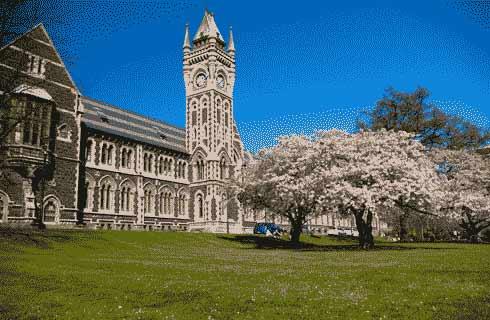景观建筑遗产与设计文学硕士
Master of Arts in Landscape Built Heritage and Design

学历文凭
Masters Degree (Taught)

专业院系

开学时间

课程时长

课程学费

国际学生入学条件
TOEFL - TOEFL 90 (Listening - 17, Reading - 18, Speaking - 20, Writing 17)
Applicants should have a degree at Second Class Honours level (or higher) in an appropriate subject in the fields of Science, Arts, Humanities, Social Science, Law, Commerce, Engineering, Architecture, or Government or similar.
Selection will be based on academic achievement, written expression of interest, an interview and any relevant work experience.
Applicants who hold a degree at a level lower than Second Class honours may also be considered following a review of their individual qualifications and their experience in a relevant field and admission will be subject to the approval of the College of Arts, Celtic Studies, and Social Sciences
For applicants whose first language is not English, evidence of proficiency in English will be required.
IDP—雅思考试联合主办方

雅思考试总分
6.5
- 雅思总分:6.5
- 托福网考总分:90
- 托福笔试总分:160
- 其他语言考试:Pearson PTE - Minimum Score of 63 with no section score below 51
CRICOS代码:
申请截止日期: 请与IDP联系 以获取详细信息。
课程简介
Drawing on the European Landscape Convention and other instruments, this MA explores the complex interrelationships that exist between built heritage, planning, design and landscape in different places. Anticipating, managing and making decisions about the character of our cities, neighbourhoods and rural areas are difficult challenges everywhere in the world. Also, these decisions are often made within the kind of technical, political and bureaucratic processes that many communities, developers and even specialists find difficult to engage with. Graduates of this MA programme will become effective and persuasive participants within these processes: their real-world and cross disciplinary skills and competencies will help to ensure that the decisions made about built environments, heritage and landscape assets everywhere will be more robust and sustainable. This programme covers the three main subject areas (Landscape, Built Heritage and Design) through a set of inter-connected teaching modules framed by a solid framework of spatial planning subjects that give it a practical, decision-making focus. The landscape component (which, for this MA, embraces both urban and rural settings) draws on technical, cultural, aesthetic and procedural perspectives as a basis for teaching and learning. The core modules address landscape context, character, open space and change at both the strategic scale (city, city- region, rural district) and at the local level (neighbourhood, site, open space). Built heritage and design are addressed through problem-solving based modules that cover urban design and conservation as well as a range of skills that cover effective communication, presentation and engagement.
相关申请
 预科
预科 奖学金
奖学金 实习机会
实习机会 在校学习
在校学习 跨境学习
跨境学习 校园授课-线上开始
校园授课-线上开始 在线/远程学习
在线/远程学习
开学时间&学费
学费信息仅供参考,请与IDP联系以获取详细信息
| 开学时间 | 时长 | 学费 | 地点 |
|---|---|---|---|
| 暂无 | 暂无 | 暂无 | 暂无 |
学校排名

世界排名301
数据源:
泰晤士高等教育世界大学排名
关于爱尔兰国立科克大学

UCC是一所世界领先的大学,以提供优秀的授课型学习项目和支持全球重要的研究社区而倍感自豪。大学的校风以促进思想多样性、知识交流和职业抱负为中心。大学与世界各地的数百所其他机构合作,拥有来自世界各地的数千名国际学生。UCC提供的16个学科领域在全球排行榜名列前茅,曾五次荣获星期日泰晤士报授予的''爱尔兰年度大学''称号,名列全球大学前2%。科克城是一座无与伦比的学习和发展之城。该城最近被命名为''联合国教科文组织学习之城'',以表彰其对卓越学习的承诺,科克是一个坐落在壮丽自然景观之中的文化中心和商业中心。UCC与爱尔兰其他地区、英国和欧洲有着奇妙的联系,无论对个人、学术或专业机构而言,UCC都是探索欧洲大陆的最佳场所。自1845年建校以来,UCC从未停止成长、发展和创新的脚步。除了卓越的研究、可持续发展的校园和全新的校园设施,大学还是来自世界各地的独特教职员工和学生社区之家。就读UCC就意味着可尽享欧洲最友好和最生气勃勃城市之生活。
本校相关课程

当代宗教文学硕士
学历文凭
Masters Degree (Taught)
开学日期
课程费用总额


文学士(荣誉)-应用心理学
学历文凭
Bachelor Degree with Honours
开学日期
课程费用总额


文学士(荣誉)
学历文凭
Bachelor Degree with Honours
开学日期
课程费用总额


犯罪学硕士
学历文凭
Masters Degree (Taught)
开学日期
课程费用总额


文学士(荣誉)-艺术(国际)
学历文凭
Bachelor Degree with Honours
开学日期
课程费用总额


文学士(荣誉)-艺术-音乐
学历文凭
Bachelor Degree with Honours
开学日期
课程费用总额

其他相关课程

Bachelor of Interior Design (Commercial)
 比利·布鲁设计学院
比利·布鲁设计学院学历文凭
Bachelor Degree
开学日期
课程费用总额


规划硕士(城市设计)/景观建筑硕士
 阿德莱德大学
阿德莱德大学学历文凭
Masters Degree (Coursework)
开学日期
课程费用总额


城市和区域规划硕士
 堪培拉大学
堪培拉大学泰晤士高等教育世界大学排名:470
学历文凭
Masters Degree (Coursework)
开学日期
课程费用总额


室内建筑学士
 堪培拉大学
堪培拉大学泰晤士高等教育世界大学排名:470
学历文凭
Bachelor Degree
开学日期
课程费用总额


城市和区域规划硕士-课程
 西澳大学
西澳大学学历文凭
Masters Degree (Coursework)
开学日期
课程费用总额


室内建筑设计学士学位
 悉尼科技大学
悉尼科技大学学历文凭
Bachelor Degree
开学日期
课程费用总额










 爱尔兰
爱尔兰